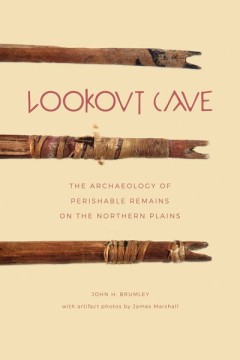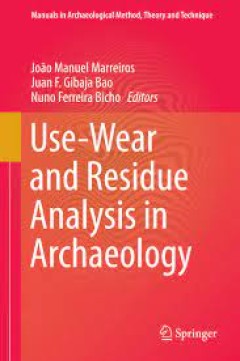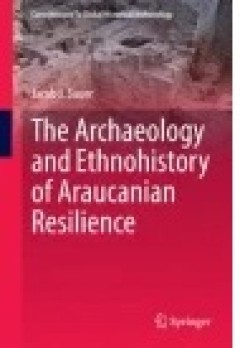Filter by

Field Archaeology from Around the World Ideas and Approaches
Field practice in archaeology varies greatly throughout the world, mainly because archaeological sites survive in very different ways in different counties. Many manuals see this as a problem - to be defeated by the imposition of standardised procedures. In this book we relish the variety of field practice, seeing it rather as the way the best archaeologists have responded creatively to the c…
- Edition
- -
- ISBN/ISSN
- 978-3-319-09819-7
- Collation
- XXXII, 245
- Series Title
- -
- Call Number
- -

Alberta’s Lower Athabasca Basin Archaeology and Palaeoenvironments
Over the past two decades, the oil sands region of northeastern Alberta has been the site of unprecedented levels of development. Alberta’s Lower Athabasca Basin tells a fascinating story of how a catastrophic ice age flood left behind a unique landscape in the Lower Athabasca Basin, one that made deposits of bitumen available for surface mining. Less well known is the discovery that this flo…
- Edition
- -
- ISBN/ISSN
- 9781926836904.01
- Collation
- -
- Series Title
- Recovering the Past: Studies in Archaeology
- Call Number
- 7 x 10, 565 pages

Lookout Cave The Archaeology of Perishable Remains on the Northern Plains
In the mid-1960s as a young high school student John Brumley visited Lookout Cave for the first time and knew immediately that the site was exceptional. The cave, located in north central Montana, was initially discovered in 1920 but it wasn’t until 1969 that a field crew from the University of Montana excavated a large portion of the remote site. The materials recovered in that excavation re…
- Edition
- -
- ISBN/ISSN
- 9781771991803
- Collation
- -
- Series Title
- -
- Call Number
- 280 pages

Light from Ancient Campfires Archaeological Evidence for Native Lifeways on …
Light from Ancient Campfires is the first book in twenty years to gather together a comprehensive prehistoric archaeological record of the Northern Plains First Nations. In this important examination of the region’s earliest inhabitants, author Trevor Peck reviews the many changes of interpretation that have occurred in relevant literature published during the last two decades. Beginning with…
- Edition
- -
- ISBN/ISSN
- 9781897425961.01
- Collation
- -
- Series Title
- -
- Call Number
- 528 pages

Alberta’s Lower Athabasca Basin Archaeology and Palaeoenvironments
Over the past two decades, the oil sands region of northeastern Alberta has been the site of unprecedented levels of development. Alberta’s Lower Athabasca Basin tells a fascinating story of how a catastrophic ice age flood left behind a unique landscape in the Lower Athabasca Basin, one that made deposits of bitumen available for surface mining. Less well known is the discovery that this flo…
- Edition
- -
- ISBN/ISSN
- 9781926836904.01
- Collation
- -
- Series Title
- -
- Call Number
- 7 x 10, 565 pages

Use-Wear and Residue Analysis in Archaeology
This book is designed to act as a readily accessible guide to different methods and techniques of use-wear and residue analysis and therefore includes a wide range of different and complementary essential topics: experimental tests, observation and record methods and techniques and the interpretation of a diversity of tool types and worked raw materials. The onset of use-wear studies was marked…
- Edition
- -
- ISBN/ISSN
- 978-3-319-08257-8
- Collation
- 15 b/w illustrations, 49 illustrations in colour
- Series Title
- -
- Call Number
- -

After Ethics: Ancestral Voices and Post-Disciplinary Worlds in Archaeology
While books on archaeological and anthropological ethics have proliferated in recent years, few attempt to move beyond a conventional discourse on ethics to consider how a discussion of the social and political implications of archaeological practice might be conceptualized differently. The conceptual ideas about ethics posited in this volume make it of interest to readers outside of the discip…
- Edition
- Ed. 1
- ISBN/ISSN
- 978-1-4939-1689-4
- Collation
- XVII, 140
- Series Title
- Ethical Archaeologies: The Politics of Social Justice
- Call Number
- 301 AFT a

Underwater Archaeology of a Pacific Battlefield The WWII Battle of Saipan
Battlefields have been the object of fascination for millions of tourists and the subjects of elaborate interpretation projects. This volume will outline the process and results of developing the WWII Maritime Heritage Trail: Battle of Saipan Project. This book will provide examples of how a group of archaeologists, managers and a community took a specific battle and transformed it from a co…
- Edition
- -
- ISBN/ISSN
- 978-3-319-16679-7
- Collation
- 10 b/w illustrations, 16 illustrations in colour
- Series Title
- -
- Call Number
- -

Historic Preservation:Caring for Our Expanding Legacy
This well-illustrated book offers an up-to-date synthesis of the field of historic preservation, cast as a social campaign concerned with the condition, treatment and use of the legacy of existing properties in the United States. Drawing on a wide range of research, experience and scholarship over the last fifty years, it allows us to re-think past and current ideas in preservation, challenging…
- Edition
- -
- ISBN/ISSN
- 978-3-319-04974-8
- Collation
- XXXVII, 383
- Series Title
- -
- Call Number
- 300 TOM h

The Archaeology and Ethnohistory of Araucanian Resilience
This volume examines the processes and patterns of Araucanian cultural development and resistance to foreign influences and control through the combined study of historical and ethnographic records complemented by archaeological investigation in south-central Chile. This examination is done through the lens of Resilience Theory, which has the potential to offer an interpretive framework for ana…
- Edition
- -
- ISBN/ISSN
- -
- Collation
- XIII, 193
- Series Title
- Contributions To Global Historical Archaeology
- Call Number
- -
 Computer Science, Information & General Works
Computer Science, Information & General Works  Philosophy & Psychology
Philosophy & Psychology  Religion
Religion  Social Sciences
Social Sciences  Language
Language  Pure Science
Pure Science  Applied Sciences
Applied Sciences  Art & Recreation
Art & Recreation  Literature
Literature  History & Geography
History & Geography